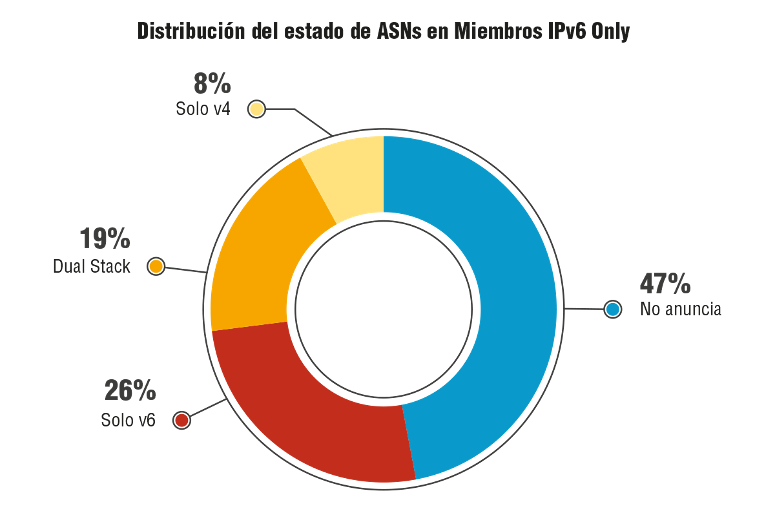Introduction
This paper seeks to analyze the announcement and status of the prefixes held by organizations known as IPv6-only LACNIC members. These are organizations that have received IPv6 prefixes, that may or may not have received an autonomous system (ASN), and that have not been assigned an IPv4 prefix by LACNIC. The results of this analysis will help us improve our understanding of the uses and needs of our members across the region.
Information sources used in this analysis
The source of information used in this analysis was LACNIC whois, with data obtained throughout the month of January 2023. This information only includes those members who have been assigned IPv6 but not IPv4 resources by LACNIC. They may or may not have been assigned an autonomous system number.
Data processing
Python3 on a Jupyter notebook. We used the public APIs of LACNIC and RIPE NCC.
LACNIC WHOIS
RIPE NCC API
APNIC IPv6 Penetration by ASN
LACNIC’s delegated-extended File:
Findings
We found 483 organizations that are considered IPv6-only LACNIC members, which we divided into:
IPv6-only members with ASN: 343 members
IPv6-only members without ASN: 140 members
Results for the 483 IPv6-only members (with and without ASN):
An analysis of the 483 members allowed us to obtain the following information:
– 261 announce the entire or a portion of the prefix
– 208 announce the entire prefix they received from LACNIC
– 53 announce a portion of the prefix they received from LACNIC
– 222 do not announce the prefix
Results for the 343 IPv6-only members with at least one ASN:
A total of 343 of the 483 IPv6-only members have at least one ASN (71%).
Out of the 343 members that have an ASN:
163 announce the prefix (47.52%)
120 announce the entire IPv6 prefix (73.61%)
43 announce a portion of the IPv6 prefix (26.38%)
180 do not announce the IPv6 prefix (52.48%)
Results for the 140 IPv6-only members without an ASN:
A total of 140 of the 483 IPv6-only members do not have an ASN (29%).
Out of these 140 IPv6-only members with no ASN:
98 announce the prefix (70%)
82 announce the entire prefix (83.67%)
16 announce a portion of the prefix (16.32%)
42 do not announce the prefix (30%)
What can we conclude from the charts above?
The first thing that stands out is that IPv6-only members without an ASN have 23% more announcements than LACNIC members who do have an ASN. In other words, these members have asked another organization to announce their prefix.
In both cases, the number of unannounced prefixes is very high, and it might be interesting to find out whether there is a reason for this.
It is particularly striking that the percentage of partial announcements is almost identical (11% of members with an ASN and 12% of members without an ASN).
Trying to identify whether the ASNs have IPv6 traffic
Knowing that there are 343 ASNs with assigned IPv6 prefixes and considering that these are also IPv6-only members, one can presume that they must have “medium high” IPv6 traffic. Therefore, we analyzed each autonomous system to determine its IPv6 traffic on 23 January 2023.
How do we find out if an ASN has IPv6 traffic?
As many of you know, APNIC has been measuring IPv6 traffic for each ASN for many years. You can learn more about these studies here: https://stats.labs.apnic.net/ipv6
Based on the above, we wanted to find out if the known ASNs of IPv6-only LACNIC members actually had IPv6 traffic (beyond announcing their prefix).
Unfortunately, we were unable to obtain information for 274 (79.88%) of the 343 autonomous systems that were analyzed. However, it is important to note that this does not necessarily mean that they have not deployed IPv6, but that the traffic generated is very low and does not appear in the measurements by APNIC. A total of 32 ASNs were reported with 0% IPv6 traffic and 1 ASN with 88% IPv6 traffic.
Are our IPv6-only members actually IPv6-only?
Finally, we wanted to find out if our members (IPv6-only with an ASN) are truly as IPv6-only as their name implies.
For this particular case, we relied on the RIPE NCC API to obtain the information presented below.
Out of the 343 IPv6-only members with at least one ASN:
– A total of 540 prefixes were being announced (including v4 and v6)
IPv4 announcements: 220
IPv6 announcements: 320
In IPv4 announcements, the average prefix length is: 23.56
In IPv6 announcements, the average prefix length is: 38.09
– 66 members “became” DualStack, i.e., the ASN announces both IPv4 and IPv6
– 90 members announce IPv6 only
– 27 members announce IPv4 only
– 160 do not announce any prefix
And to which RIR do the IPv4 prefixes announced by IPv6-only LACNIC members belong?
LACNIC ARIN RIPE NCC AFRINIC APNIC
28 166 17 9 0
Sankey Diagram – A Look at LACNIC’s IPv6-Only Members
Conclusions
Results suggest that, while a significant number of LACNIC members consider themselves to be IPv6-only, we observed that more than 50% of these members have not started announcing their IPv6 prefix. At the same time, we noticed that many of those who have deployed IPv6 continue to use IPv4. This means that, although in recent years IPv6 adoption has grown in the region, there is still a long way to go to achieve widespread IPv6 deployment. In any case, it is important to continue to monitor the adoption of the new protocol.
Finally, being an IPv6-only LACNIC member also allows an organization to participate in the Internet ecosystem.









